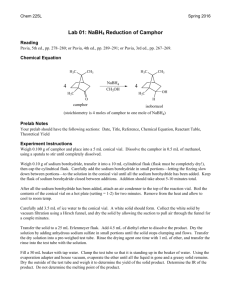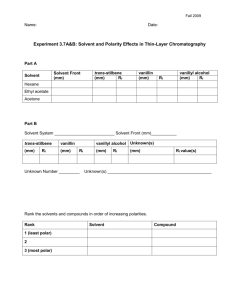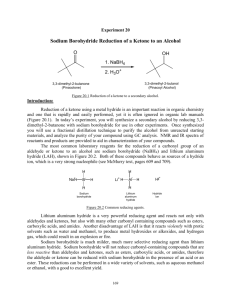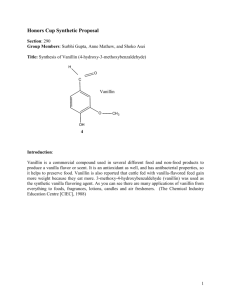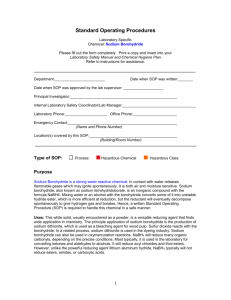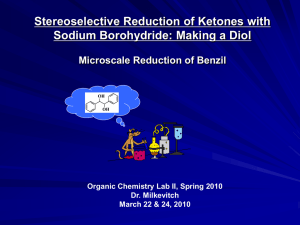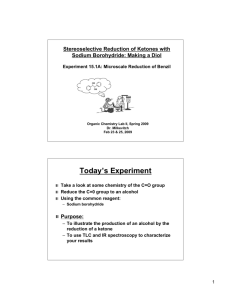Sodium Borohydride Reduction of Vanillin
advertisement
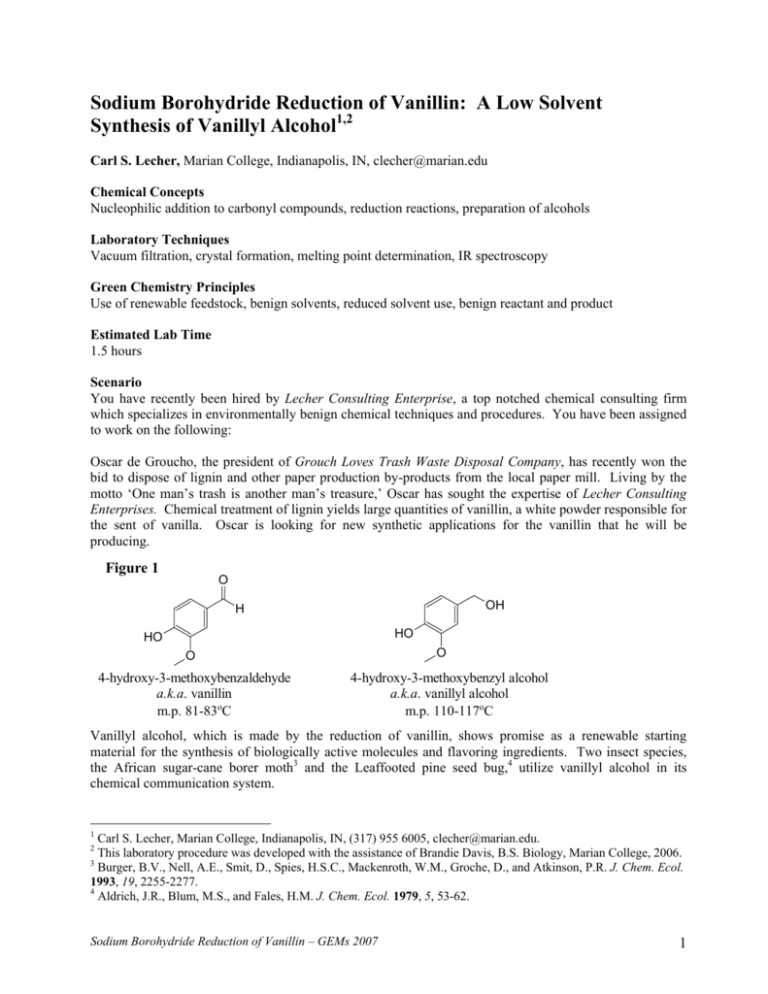
Sodium Borohydride Reduction of Vanillin: A Low Solvent Synthesis of Vanillyl Alcohol1,2 Carl S. Lecher, Marian College, Indianapolis, IN, clecher@marian.edu Chemical Concepts Nucleophilic addition to carbonyl compounds, reduction reactions, preparation of alcohols Laboratory Techniques Vacuum filtration, crystal formation, melting point determination, IR spectroscopy Green Chemistry Principles Use of renewable feedstock, benign solvents, reduced solvent use, benign reactant and product Estimated Lab Time 1.5 hours Scenario You have recently been hired by Lecher Consulting Enterprise, a top notched chemical consulting firm which specializes in environmentally benign chemical techniques and procedures. You have been assigned to work on the following: Oscar de Groucho, the president of Grouch Loves Trash Waste Disposal Company, has recently won the bid to dispose of lignin and other paper production by-products from the local paper mill. Living by the motto ‘One man’s trash is another man’s treasure,’ Oscar has sought the expertise of Lecher Consulting Enterprises. Chemical treatment of lignin yields large quantities of vanillin, a white powder responsible for the sent of vanilla. Oscar is looking for new synthetic applications for the vanillin that he will be producing. Figure 1 O OH H HO HO O O 4-hydroxy-3-methoxybenzaldehyde a.k.a. vanillin m.p. 81-83oC 4-hydroxy-3-methoxybenzyl alcohol a.k.a. vanillyl alcohol m.p. 110-117oC Vanillyl alcohol, which is made by the reduction of vanillin, shows promise as a renewable starting material for the synthesis of biologically active molecules and flavoring ingredients. Two insect species, the African sugar-cane borer moth3 and the Leaffooted pine seed bug,4 utilize vanillyl alcohol in its chemical communication system. 1 Carl S. Lecher, Marian College, Indianapolis, IN, (317) 955 6005, clecher@marian.edu. This laboratory procedure was developed with the assistance of Brandie Davis, B.S. Biology, Marian College, 2006. 3 Burger, B.V., Nell, A.E., Smit, D., Spies, H.S.C., Mackenroth, W.M., Groche, D., and Atkinson, P.R. J. Chem. Ecol. 1993, 19, 2255-2277. 4 Aldrich, J.R., Blum, M.S., and Fales, H.M. J. Chem. Ecol. 1979, 5, 53-62. 2 Sodium Borohydride Reduction of Vanillin – GEMs 2007 1 Background Vanillin (4-hydroxy-3-methoxybenzaldehyde), a pleasant smelling aromatic compound, occurs naturally in the pods of the vanilla plant (Vanilla planifolia), which is native to Mexico.5 Although the finest vanilla flavoring is still obtained from natural vanilla, synthetic vanillin is far less costly. It is used widely as a flavoring additive for beverages, cooking, and as an aromatic additive for candles, incense, potpourri, fragrances, perfumes, and air fresheners. It is also used as a starting material for the synthesis of such drugs as L-dopa, which is used for treating Parkinson's disease. At one time synthetic vanillin was made mostly from isoeugenol, a naturally occurring and widely used perfume ingredient. Most vanillin is now synthesized using lignin derived from wood pulp. Lignin is a complex polymer that gives rigidity to trees and other woody plants. After cellulose, lignin is the second most abundant organic material on earth. Reduction Reactions In chemistry, reduction refers to the gain of electrons. This is usually manifested through the gain of hydrogen atoms or a loss of oxygen atoms, or both. For example, a carbonyl compound is reduced to an alcohol when its carbonyl group gains a hydride and a proton. Reducing Agents When lithium aluminum hydride (LiAlH4) was introduced as a reducing agent in the late 1940s, it brought about a revolution in the preparation of alcohols by reduction. At that time, the most popular reducing agents for carbonyl compounds were sodium metal and gaseous hydrogen under pressure. The greater simplicity and convenience of hydride reduction soon made it the preferred method for a broad spectrum of chemical reductions. Lithium aluminum hydride is a powerful reducing agent whose high reactivity is a disadvantage in some applications. Because it reacts violently with water, alcohols, and phenols to release hydrogen gas, it can be used only in aprotic solvents, such as ether under strictly anhydrous conditions. By contrast, sodium borohydride (NaBH4) is a much milder reducing agent that is comparatively safe to handle in its solid form. Unlike lithium aluminum hydride, it can be used even in aqueous or alcoholic solutions. Reaction Stoichiometry The overall stoichiometry of the sodium borohydride reduction of vanillin is given by the following equation: O H + NaBH + 4 H O 4 2 4 OH 4 + H3BO3 + NaOH HO HO O O Scheme 1. Reaction Stoichiometry In practice, it is best to use a 50-100% excess of sodium borohydride to compensate for any that reacts with the solvent or decomposes from other causes. Since the reaction is first order in sodium borohydride (as well as the carbonyl compound), using an excess will also increase the reaction rate. 5 Vanillin is actually not found in the fresh vanilla bean, but is formed by the enzymatic breakdown of a glucoside during the curing process. Sodium Borohydride Reduction of Vanillin – GEMs 2007 2 Reaction Solvents Sodium borohydride reductions are usually carried out in a dilute (~1 M) aqueous NaOH solution or an alcohol. The reagent is not stable at low pH, and even in a neutral aqueous solution it decomposes to the extent of about 4.5% per hour at 25°C. Acidic functional groups, such as COOH and the OH group of a phenol, may cause rapid decomposition of sodium borohydride. Sodium borohydride reacts slowly with alcohols, but ethanol and methanol are usually suitable solvents when there are no acidic functional groups and the reaction time is no more than 30 minutes at 25°C. Reaction Conditions In most reactions with sodium borohydride, the aldehyde or ketone is dissolved in the reaction solvent and a solution of sodium borohydride is added, with external cooling if necessary, at a rate slow enough to keep the reaction temperature below 25°C. Higher temperatures may decompose the hydride, and adding the carbonyl compound to the alkaline sodium borohydride solution may cause side reactions of base-sensitive substrates. The amount of solvent is not crucial, but enough should be used to completely dissolve the reactants The time required to complete the reaction depends on the reaction temperature and the reactivity of the substrate. Most reactions of aldehydes and aliphatic ketones are complete in 30 minutes at room temperature. Workup of the Reaction Mixture After the reaction is complete, the excess sodium borohydride is decomposed by acidifying the reaction mixture to pH 6 or below (slowly and while stirring) using aqueous HCl. Hydrogen gas is evolved during this process as the excess sodium borohydride decomposes. Depending on the properties of the product and the reaction solvent used, the product can be separated from the reaction mixture by filtration, extraction, or partial evaporation of the solvent followed by extraction. Purification The product can be purified, if needed, by any appropriate method based on its physical state and properties. Vanillyl alcohol is soluble in hot water, hot and cold ethanol, and hot and cold ether. It is relatively insoluble in cold water and it tends to form supersaturated solutions in water. separatory funnel In the lab It is your task to carry of the reduction of vanillin, and to analyze the procedure ring stand gap 25 mL round bottom flask ice bath 7 6 5 7 4 8 9 10 1 3 8 2 9 6 stir plate 5 4 3 2 11 1 Figure 2. Apparatus Sodium Borohydride Reduction of Vanillin – GEMs 2007 3 Scheme 2. Reaction Scheme O OH H 1. NaBH4 2. H3O+ workup HO HO O 4-hydroxy-3-methoxybenzaldehyde a.k.a. vanillin m.p. 81-83oC C8H8O3 = 152.15 O 4-hydroxy-3-methoxybenzyl alcohol a.k.a. vanillyl alcohol m.p. 110-117oC C8H10O3 = 154.16 Reaction Table Name vanillin NaBH4 (3.42 M in 1.0 M NaOH) Formula Weight 152.15 37.83 density --- eq mmol wt / vol 1.00 17.1 2.60 g 1.00 17.1 5.0 mL *note: use YOUR weight and YOUR volume for your reaction table Safety Precautions Hydrochloric acid: Hydrochloric acid is corrosive and a chemical burn hazard. Avoid contact. If contact is made with the skin, wash the affected area with cold water for 15 minutes. NaBH4 solution: NaBH4 solution is caustic and will decompose violently with acid. Handle with care. Experimental Procedure Synthesis of Vanillyl Alcohol 1. Weigh between 2.5 and 2.6 g of vanillin into a 50 mL beaker. Record the weight directly into your notebook to the maximum accuracy of the balance. 2. Fill out your reaction table by calculating the mmol and equivalents of reagents used based on YOUR mass of vanillin. 3. Transfer the vanillin to a 25 mL round bottom flask using a solid addition funnel. Rinse your beaker and funnel with 5.0 mL of ethanol.6 This ethanol will be the solvent for the reaction. 4. Add stir bar and dissolve the vanillin. If the vanillin does not dissolve, gently warm the flask with your hand. 5. Read thoroughly before starting this step! Set up the reaction as follows: a. Add 5.0 mL of NaBH4 solution to a dropping funnel. b. Clamp the 25 mL round bottom flask in an ice bath as depicted in Figure 2, and immediately procedure to the next step. 6 Safety note – As a general safety rule, solutes should be added to solvents. The resulting solution should go from dilute to more concentrated. This is because the solvation process for some compounds can be violently exothermic. Sodium Borohydride Reduction of Vanillin – GEMs 2007 4 c. To the 25 mL round bottom flask, add the NaBH4 solution DROPWISE with stirring over a period of 10 minutes. Add the first mL especially slow, as a large amount of heat is evolved. i. You may monitor the temperature of the reaction. If so, keep the reaction temperature below 25°C. d. Note any observations. 6. After addition of NaBH4 solution is complete, remove the ice bath. Stir the reaction at room temperature for 5 minutes to ensure that the reaction has gone to completion. 7. Return the ice bath to the apparatus. Add 6 M HCl DROPWISE with stirring until H2 gas is no longer evolved. Check the pH to verify that the solution is now acidic. 8. Continue to cool with stirring in the ice bath for 10 minutes. A precipitate will form. Separation 9. Collect the solid by vacuum filtration. Use small portions (~1 mL) of ice-cold DI water to aid the transfer of the solid into the filter funnel and to wash the product. With the vacuum applied, allow the solid to dry on the vacuum for about two minutes. 10. Air dry product to a constant mass in the fume hood for at least 24 hours. (Do NOT oven dry.) 11. The filtrate may be disposed of via the sink with copious amounts of water. 12. Weigh your dried product. Make sure to account for the weight of the filter paper. Characterization and Calculations 13. Determine the theoretical yield and percent yield for the reaction. 14. Determine the melting point of your substance using a Mel-Temp apparatus. 15. Generate an IR Spectrum for your product. Record important signals in the data section of your notebook. 16. Confirm the identity of your product. Disposal 17. When you are satisfied with your data and calculations, place your product in the container labeled VANILLYL ALCOHOL. The instructor will save this compound for future use. Sodium Borohydride Reduction of Vanillin – GEMs 2007 5 Assignment In addition to the lab notebook, answer the following questions: 1. The scenario states that vanillin and vanillyl alcohol are renewable starting materials. What is the difference between renewable and non-renewable resources? Which would be considered to be greener? 2. Based on the reaction stoichiometry highlighted on page 2, what is the molar ratio between vanillin and NaBH4? 3. Based your observations during the addition of the NaBH4 solution to the vanillin, and your understanding of pKas, predict why excess NaBH4 solution is required. 4. Draw the mechanism for the reduction of vanillin. Be sure to account for the generation of H2. 5. What purification technique would be the most appropriate for the purification of vanillyl alcohol? Explain your rationale. 6. Obtain a 1H NMR spectrum for vanillyl alcohol from your favorite spectral database. Attach this spectrum and assign the major peaks. 7. Calculate your theoretical yield and percent yield for the reaction. 8. Does your percent yield make sense? If your percent yield is more that 100% or less than 65%, describe potential reasons for your yield. 9. Calculate the atom economy for the reaction. For the reagents, consider only the mass MW of the vanillin and sodium borohydride. Atom economy = (MW desired product / combined MW of all reagents) x 100% 10. Would you consider this reaction to be atom efficient? Justify your answer. 11. Calculate the effective mass yield for the reaction. For NaBH4, be sure to use the mass of the NaBH4, not the mass of the NaBH4 solution. Ignore the mass of the reagents used for the workup. Effective mass yield = (mass of desired product obtained / combined mass of all reagents used) x 100% 12. Identify the possible components of the aqueous filtrate. Is it appropriate to disposed of the filtrate via the drain? Explain your rationale. 13. What is the solvent for this reaction? Is this a green solvent? How does the absence of traditional solvents improve the greenness of the reaction? 14. How is the product isolated from the reaction mixture? How does this technique minimize the need for additional solvents? 15. Does the reaction need to be performed with the protection of a fume hood? How doe this effect the overall safety of the experiment? Sodium Borohydride Reduction of Vanillin – GEMs 2007 6 16. Essay: Green Chemistry looks to eliminate both the use of hazardous reagents and the generation of hazardous products. Green chemistry minimizes environmental impact while maximizing safety. Evaluate the procedure, in its totality, for greenness. a. Describe at least 4 aspects of the procedure that contribute to its greenness (you may use those previously mentioned). b. Suggest at least two ways to improve the procedure. Requirements: Please type explanations. Work calculations by hand. Show all work. Due: Sodium Borohydride Reduction of Vanillin – GEMs 2007 7 Result Submission Form Lab Title: Sodium Borohydride Reduction of Vanillin: A Low Solvent Synthesis of Vanillyl Alcohol Name: ______________________________________________ Semester and Year: _________________________________ Reaction Scheme: O OH H 1. NaBH4 2. H3O+ workup HO O HO O Your Reaction Table Name Formula Weight density vanillin 152.15 -- NaBH4 37.83 -- eq mmol wt / vol other reagents not needed in this table Your Results Mass Product Theoretical Yield % Yield Melting point range other values not needed in this table Explain any reasons why your yield would be lower than expected: Make at least 1 suggestion for improving the lab: Sodium Borohydride Reduction of Vanillin – GEMs 2007 8
